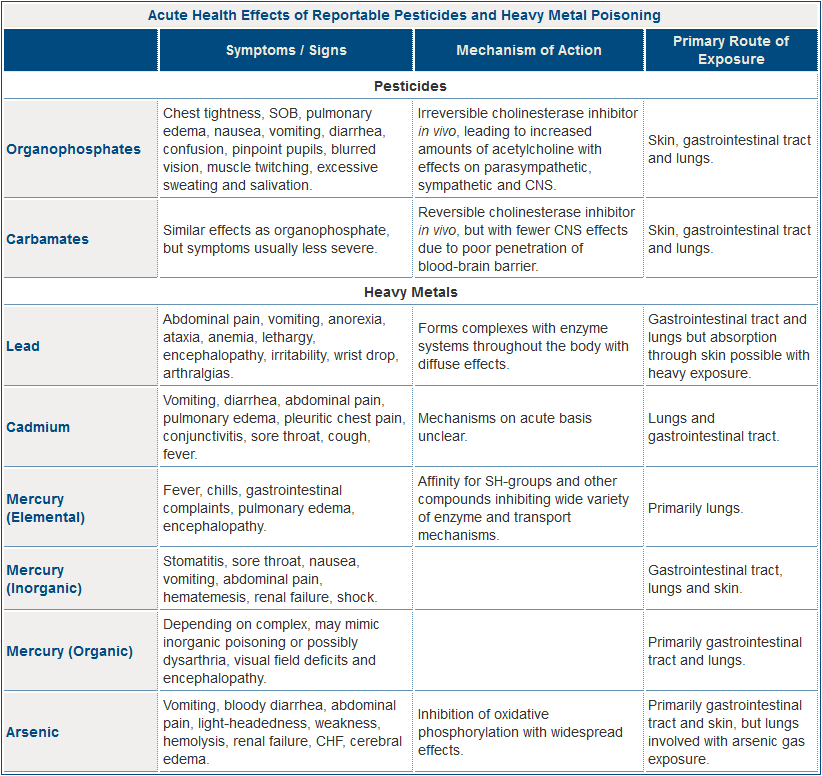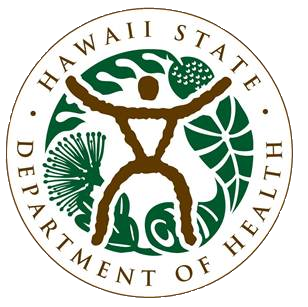Pesticide and Heavy Metal Poisoning
To help recognize environmental illness and injury and to aid in the protection of public health, HDOH has made heavy metal poisoning reportable conditions. Pursuant to Hawaiʻi Administrative Rule 11-5, physicians and laboratory directors are required to report cases or suspected cases of pesticide or heavy metal poisoning. Reporting can occur via phone or electronically and requires specified demographic data designed to aid in the identification of environmental hazards. HDOH recognizes that successful control of environmentally related conditions depends on two factors: recognition and diagnosis of cases by health care workers, and the implementation of surveillance, prevention, and control programs.
In order to meet these needs, the HEER office will:
- Maintain statewide surveillance data;
- Manage the reported cases, including followup studies, if necessary; and
- Develop and coordinate related surveillance activities including physician education seminars, public information dissemination, and technical consultation.
It is expected that this will heighten physician awareness, increase present knowledge, and encourage the reporting of pesticide and heavy metal poisoning.
REPORTING PROCEDURES
In case of a suspected pesticide exposure, see the Report a Pesticide Poisoning (for Healthcare Providers) page for instructions.
Health care providers are required to report to the HDOH within one day any case of pesticide or heavy metal poisoning as specified in the table below. For reporting purposes, pesticide and heavy metal poisoning include acute poisoning or any subacute illness caused by, or believed to be caused by, these toxic agents.
For reporting purposes, call (808) 586-4249 on Oʻahu, or 1-800-468-4644 ext 64249 from the Neighbor Islands.
Reports provided to the HDOH about persons diagnosed with an environmentally related illness or injury shall be confidential, as specified in HRS §321-315. For toxicology reports on the pesticides and metals contact the HEER Office.
BIOMONITORING STUDIES
Please follow the links below to read the Hawaiʻi Department of Health Mercury and Arsenic Biomonitoring Study results.
- Biomonitoring Pilot Study Hair Mercury Levels in Clients Attending the Special Supplemental Nutrition Program for Women, Infants and Children (WIC) Program February 2018
- Biomonitoring Pilot Study Hair Arsenic Levels in Clients Attending the Special Supplemental Nutrition Program for Women, Infants and Children (WIC) Program February 2018
INSTRUCTIONS FOR HANDLING OF BIOLOGICAL PESTICIDES AND ANALYSIS OF BLOOD/URINE SAMPLES
In addition to any routine medical tests to be performed in the work up of a case, there are several laboratory tests specific for suspected cases of pesticide poisoning. Blood and urine specimens can be analyzed for the presence of pesticide residue. Confirmation of acute organophosphate exposure is possible by measurement of plasma cholinesterase (pseudo-cholinesterase) and red blood cell (RBC) cholinesterase (acetylcholinesterase) levels. To be the most reliable, specimens should be collected as soon as possible after exposure and prior to giving any antidotal therapy, if feasible.
Blood
Given the usual uncertainty about the specifics of chemical exposure, it is best to draw several tubes of blood which may be used for analysis, if needed.
- Draw one or two (5-10 ml) samples into heparinized (green top) tubes. This sample may be used for cholinesterase testing, if appropriate for the suspected pesticide exposure. Consult with the laboratory performing the analysis for specific instructions, as methods vary.
- Draw one sample (5-10 ml) into glass tube (red top), with no heparin or preservative. Remove rubberized stopper and cover it with foil, and replace stopper. Tape down stopper. This sample can then be used for analysis of pesticide residues.
- Samples which can be delivered to a lab within 24 hours of drawing should be kept refrigerated. If delivery time will exceed 24 hours, samples should be frozen.
Urine
Samples may be collected in a plastic container unless poisoning by a chlorinated compound is suspected, in which case a glass container is preferable. Do not use any preservative. Samples should be handled and shipped in the same manner as blood.
Other Biological Media (Gavage, Stool, Adipose Tissue)
Use glass containers and freeze samples; ship frozen and package with dry ice or blue ice packs.
Non-Biological Samples
Sometimes it is necessary to analyze a drenched piece of clothing to confirm the identity of a pesticide after an accidental exposure. Samples of material should be double bagged in polyethylene bags and packaged separately from other samples for shipment and analysis. If a sample of a pesticide product is sent for analysis, it should be in a glass container, clearly labeled, and sent separately to avoid cross contamination of biological samples.
ACUTE HEALTH EFFECTS

